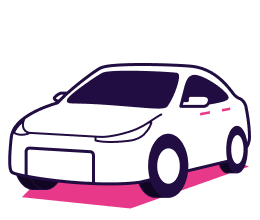What To Do If You Hit a Deer: Follow These 6 Simple Steps
 Editorial Standards
Editorial Standards SmartFinancial Offers Unbiased, Fact-based Information. Our fact-checked articles are intended to educate insurance shoppers so they can make the right buying decisions. Learn More
Often abrupt and frightening, a deer collision can leave many drivers panicked and unsure of what to do next. Staying calm and taking the proper steps can help you stay safe and protected, especially when deer collisions spike during the fall and winter. This guide will break down step-by-step how to respond after a deer collision.
What To Do After a Deer Collision
If you ever encounter a deer collision, do your best to stay calm as you take the following steps:
-
Pull to the side of the road: Slowly drive to the side of the road so you're not obstructing traffic. Stay alert — one deer is often a sign of more deer nearby.
-
Turn on your hazard lights: Your hazard lights will alert other motorists to take extra caution when passing you.
-
Document the incident: As soon as it's safe, step out of your vehicle and take photos of the vehicle damage, the roadway and any injuries. Do NOT approach the deer, as it may be dangerous.
-
Keep an eye out for safety issues: Look for any issues that could make it hazardous to drive, including leaking fluid, broken lights and loose parts. If the damages make it unsafe to drive, you should call for a towing service.
-
Report the incident: Depending on your state, you may need to report the incident to the police. If you plan to file a claim, a police report may be helpful.
-
Contact your insurance company: You will want to find out if the claim is covered. Your insurance carrier may request additional information and photos while you're still on the scene.
Does Car Insurance Cover Hitting a Deer?
Coverage against deer accidents typically falls under comprehensive coverage in your insurance policy. Collision coverage is different because it covers collisions against objects (other than animals). Comprehensive coverage protects against random and unpredictable events, such as a deer darting across the highway.
That said, a deer incident could lead to different scenarios protected under different coverages:
| Scenario | Comprehensive | Collision | Medical Payments |
|---|---|---|---|
| A deer darts across the road and strikes your car. | ✓ | ||
| Your vehicle suffers tire damage after colliding with a dead deer. | ✓ | ||
| You lose control after swerving to avoid a deer and strike a tree. | ✓ | ||
| Your passengers suffer injuries due to the deer collision. | ✓ |
IMPORTANT: Be sure to understand exactly what your policy covers, as it may vary by the insurance carrier.
How To File a Claim After Hitting a Deer or Other Wildlife
You can file a claim online, by phone, or by mobile app depending on your insurance company. If possible, call your insurance carrier to receive immediate guidance while you're still on the scene. Depending on your policy, your insurance carrier may arrange rideshare services if your car is inoperable.
Your insurance carrier will confirm if the claim is covered. Since the cost of a deer collision can go up to $4,000 or more, you should know your deductible amount, which you must pay, and how much your insurance company will cover thereafter.
5 Tips On How To Avoid Hitting a Deer
The following tips can help you avoid collisions against deer or other wildlife (e.g., elk, bears, moose, foxes, coyotes, rodents, cats and dogs).
-
Watch for yellow caution signs: Typically present near mountains, forested habitats, and rural areas, these signs notify drivers that they are approaching areas with higher deer populations.
-
Know deer peak hours: A deer hit by a car at night is more likely since deer-vehicle collisions typically occur from dusk to dawn. Also, be especially conscious of deer crossings from October to December, which is considered deer migration and mating season.
-
Steer clear of poor driving conditions: Drive during daylight hours and clear weather whenever possible. When there is no oncoming traffic, use your high beams during poor visibility (e.g., nighttime, fog, rain) to reduce the chances of a deer getting hit by a car.
-
Stay in the middle lane: Driving in the center lane gives you more time to react if a deer darts onto the road.
-
Don't swerve: Swerving could lead to control loss of your vehicle, potentially resulting in a more costly or life-threatening disaster. Instead, brake firmly without swerving.
Accidents Happen, Smart Financial Can Help
Accidents happen, and you'll want to be prepared when they do. Many drivers don't realize that they need comprehensive coverage — not basic collision coverage — for damages resulting from hitting a deer. Let SmartFinancial be your tool for staying safe and protected against deer collisions and more. Our side-by-side quote comparisons of 200+ insurance companies can help you choose the right auto insurer for your needs and budget.Just enter your zip code below for a free auto insurance quote.
- Insurance quotes /
- Auto /
- Deer Hit By Car






